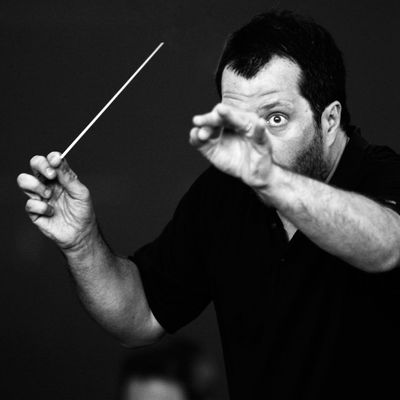
If you’d like a glimpse of the future of symphonic music — or if you just want to know what devilish majesty the New York Philharmonic will shortly unleash — this two-year-old YouTube video from the Proms in London is a good place to start. It shows the world premiere of Thomas Adès’s Totentanz (Dance of Death), which the Philharmonic will perform March 12 through 14. Or you could give Andrew Norman’s equally gob-smacking Play a whirl; that piece, too, is from 2013, but the killer world-premiere recording by the Boston Modern Orchestra Project has just come out, and although only a live performance can do this wild score justice, those are still extremely rare.
These two not-yet-senior composers — Adès is English and 44, Norman Californian and 35; both overflow with bravado — have double-handedly resurrected the grand symphonic manner that, like the novel and the painting, has died any number of times. Adès’s piece — which he’ll conduct, on a program along with Berlioz and Beethoven — is a morbid study of the inexorable, pitting a baritone Reaper against a soprano who sings all the human roles. Norman’s Play is a Ritalin rhapsody based on the title’s multiple meanings. Gamesmanship and death: The two topics aren’t really so far apart, and both pieces weave a spell of apocalyptic glee. Adès’s characters dance their way to the beyond. Norman’s light-footed score keeps threatening to vaporize into rattles and ghostly mutterings. At a time when orchestras are gasping for ways to be modern, when so many composers write for pared-down custom ensembles, and when minimalism has become practically scriptural, these dense, theatrical, and exhilarating pieces offer a way forward — two ways forward, actually — for the symphonic tradition.
Adès based his work on a 15th-century painting by Bernt Notke (or, rather, an 18th-century copy) that hung in the Marienkirche in Lübeck until 1942, when the Allies bombed the church and the city virtually out of existence. In the painting, Death forces everyone, pope, peasant, and toddler, to join in a final, wild dance. (How ironic that this fragile monument to finality should have been destroyed in a total war — death murdering death.) Adès, like his dark protagonist, leaves nothing out. Sacramental Renaissance passages; evocations of Bach (who may have played the church’s now-pulverized organ); a rapturously gloomy nod to Mahler; another to Ligeti’s ghoulish opera Le Grand Macabre; tottering dances, lurching rhythms, and so on … Adès piles a cornucopia of vivid moments into a lurid vanitas.
One of his enduring talents is that he finds clarity in complexity. His music has never been more layered, serious, and overpowering than it is here, but it is also crystalline. At any given instant he draws your ear to this sparkling detail or that, delivers a thrilling blow, then backs off into an expanse of potent quiet. His orchestra is huge, filling up the stage, vibrating through the hall’s girders and then pulling back to an immense, powerful quiet. That’s what happens when you set an enormous bass drum on its side like a domesticated UFO and let the audience wait nervously until it’s struck. It gets struck, and both the impact and the subsequent silence have the capacity to shock.
Adès and Norman share an expansive sense of space. They write big music for big halls, and it only partly fits into the flattening confines of a recording. “I wish you could all see Play performed live,” Norman writes in the CD liner notes. The at-home audience will miss the visual impact of 100 orchestra musicians behaving strangely. “You’re not going to see how players often freeze in place, mid-breath and -bow stroke, waiting to be turned on again by the flick of a percussive switch.” Play is a work of wordless theater, and it needs to be experienced in its natural habitat, the concert hall.
From the starting downbeat, the symphony explodes in full freak-out mode, as if you had just opened a soundproof door onto a roomful of overcaffeinated toddlers. Listen again to those first seconds and the thoughtfulness behind the chaos becomes self-evident. The rapid-fire clunk-blat-whoosh of timbres, the sense of hurtling, the harmonic instability — Norman must have spent weeks laboring over that brief volcanic passage. Already in the 2008 orchestral work Unstuck, he showed that he could create that kind of kinetic lunacy, and he’s not alone in that facility. It’s almost a rite of passage for the young, overeducated American composer to write a 12-minute work of orchestral razzmatazz. But Norman stretches it to 45 minutes of relentless excitement, the musical equivalent of a ten-mile sprint. Along the way, ideas whiz by before they can be grasped, leaving listeners with the uncomfortable feeling that they’re not listening fast enough. Unease about speed is the adrenaline dispenser in video games, when you’re always one shot, or one flick of the joystick, away from catastrophe.
What holds the whole contraption together is what the composer calls a “wedge-shaped motive,” a set of scales that march in opposite directions at the same time. In its most straightforward form, that gambit is a counterpoint exercise; here the simple tool gives the music a constant sense of deconstruction, an iceberg breaking apart. It’s not all overdrive all the time, though. One of my favorite passages is a stretch of hollow pluckings and scratchings at the start of “Level 2” that gradually gathers in hushed intensity until the inevitable fortissimo detonation. Norman isn’t frightened of quiet. Later in the same movement, trembling, soothing chords swell out of silence, then gently fall back in. The whole piece ends with that up-and-down theme spelled out slowly in soft, single notes that drift into blackness, the last survivor’s exhausted Dance of Death.


